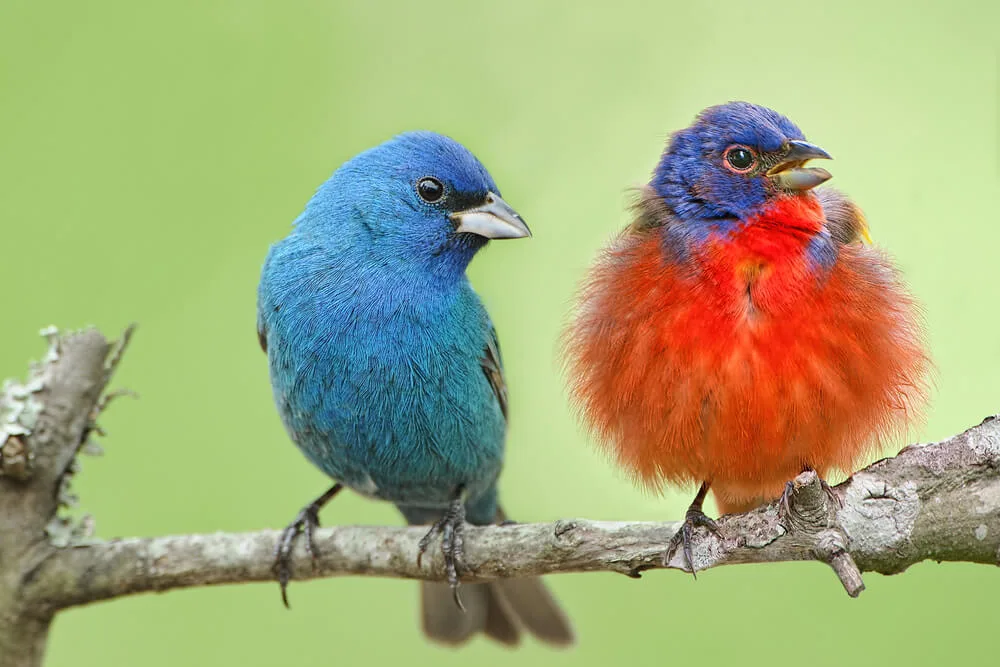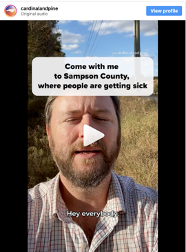
What a showoff. An otherwise beautiful male indigo bunting (left) looks rather plain in comparison to the male painted bunting, one of 7 elusive North Carolina birds to watch. (Shutterstock)
From Crayola-colored buntings to a bird that looks like a flame in flight, we’ll tell you where to find some of our favorite feathered friends.
While more than 469 bird species have been observed in North Carolina, we are going to take a closer look at 7 rare birds that should be on every birdwatcher’s bucket list.
And don’t worry, we’ll also point you in the direction of where and when to find them across the state. While some may require a bit of bushwhacking, many of these birds can show up in your backyard when tempted with the right bird feed.
So get out your bingo cards, because from the best Ewok impersonator to the pickiest nester, it’s time for some rare bird bingo.
Painted Bunting

Painted Buntings look like an 8-pack of Crayolas melted and took wing, but in a good way.
They spend most of their time hidden in the dense estuary foliage. They’re just trying to blend in. But it’s not an easy task between their flamboyant plumes and beautiful birdsong.
Search for them along North Carolina’s coastal wetlands and islands from April through October. Though if you’re lucky you may find a Painted Bunting camouflaged perfectly among Airlie Garden’s bright flowers.
For backyard birders, check out the Painted Bunting’s slightly more ubiquitous cousin, the Indigo Bunting. This iridescent blue bird is happy to come to feeders for seed across the whole state.
Northern saw-whet Owl

The Northern saw-whet owl is the rarest breeding owl in North Carolina. At only six inches tall, these owls may look more like a beanie baby than a fierce predator. It doesn’t help that the poor bird is mostly head or that fledgling Northern saw-whets look like lost Ewoks. But don’t be fooled. When their bright yellow eyes hone in on a deer mouse, things get serious.
Northern saw-whet owls prefer pine forests, a North Carolinian specialty. However, they are still hard to spot because of their reclusive nature.
Your best bet for spotting one is in a pine forest in the summer. Listen for their namesake: a distinct high pitch too-too-too that sounds like someone whetting a saw (not at all creepy). Lucky birdwatchers have found these owls along the western border of the state from the Tanawha Trail in the Grandfather Corridor to the Black Mountains.
Eastern Towhee

Is it just me or does North Carolina specialize in particularly snuggly birds?
While the Eastern Towhee can be found visiting birdfeeders across the state, the Appalachian mountains are a rare southern breeding ground for these muffin-like birds, which resemble brighter and chunkier robins.
Leave them a generous offering of seeds in your backyard feeder, though you may only get one. Towhees are very territorial–males have been known to defend areas larger than what is necessary for sustenance.
To spot one of these birds in the wild, listen for the Eastern Towhee’s unique call: chewink! Towhees are often at ground level, rustling around for snacks in the dry leaves.
Golden-crowned Kinglet

The Golden-crowned Kinglet and I have a few things in common.
We’re both new Southerners. I moved from the northeast to North Carolina around 2020. So did the kinglet, which has expanded its breeding grounds into the Appalachian Mountains.
Golden-crowned Kinglets are very hyper and busy. And they also like to awkwardly bring unsweetened ice tea to cookouts. Oh wait. Guess that’s just me.
A cross between Audrey Hepburn and a squishmallow (check out that black eye-liner and marshmallow bod), Golden-crowned Kinglets are about the size of a hummingbird. They also have a vibrant yellow mohawk.
Between their size and preference for flying high up in the foliage, these goobers are hard to spot in the wild. The good news: Even though their year-round home is in the Blue Ridge Mountains, they like to winter by bird feeders in the Triangle and the eastern part of the state.
Brown-headed Nuthatch

This bird may sound like your dog’s favorite squeaky hamburger, but do not doubt its intelligence.
The Brown-headed Nuthatch is one of the rare few animals that know how to use tools: they use pieces of bark to pry loose tree bark in search of juicy snacks. Brown-headed Nuthatches also love family road trips (or codependent friend squads), often traveling in large noisy groups and engaging in group-grooming.
Their color scheme is a bit “plain Jane” — gray back, white belly and cheek, and brown cap, but the Brown-headed Nuthatch wants to be friends with you for life. They are non-migratory, enjoy piney areas all over the state, and will revisit the same bird-feeders throughout their lives.
Red-cockaded Woodpecker

The Red-cockaded Woodpecker will only live in 80-100 year old pine trees that are infected with red heart fungus (which makes it easier for them to carve out the cavities where they lay their eggs).
The problem with being the pickiest bird in North Carolina is that they are becoming endangered. These days, most pine trees are harvested decades before they reach prime Red-cockaded Woodpecker real estate.
The best place to find Red-cockaded Woodpeckers are in nature preserves specifically set up for these scrupulous birds. Look for them near Fayetteville in the Weymouth Woods Sandhills Nature Preserve, or by coast in the Croatan National Forest and the Green Swamp Preserve.
Watch out for pine-trees with flowing pine sap–this may be a sign that a Red-cockaded Woodpecker has carved out a home there.
Blackburnian Warbler

If you just happen to find yourself wandering the Pink Beds Recreation Area in April you may be lucky enough to see what looks like a flame in flight.
The Blackburnian Warbler, a small bird whose plumage resembles a glowing ember, may winter in South America but loves to spend the spring in Transylvania County, NC.
While these Warblers only breed in western NC, the whole state is part of these small-but-mighty flyers’ migration path. Try coaxing the Blackburnian Warbler into your backyard with a mealworm feeder (seeds are not their cup of, well, worm juice).
Hope to see you and your bingo card on the birding trails. I’ll be the one with the canteen of decaf, unsweetened ice tea.

Op-Ed: Studying the Holocaust remains vital to ensuring it never happens again
International Holocaust Day will be observed on January 27, 2024. This day commemorates the liberation of the Auschwitz concentration camp by the...

VIDEO: How Rural Broadband Is Coming to This North Carolina County
More than 1.1 million North Carolinians lack access to high-speed internet, a necessity of the modern economy. In Warren County, help is on the way,...

VIDEO: Sampson County puts Biden’s promise to boost rural infrastructure to the test
Locals in this rural NC county say their water and air is polluted by a PFAS-contaminated landfill, massive hog and poultry farms, and industrial...

VIDEO: Sampson County puts Biden’s promise to boost rural infrastructure to the test
Locals in this rural NC county say their water and air is polluted by a PFAS-contaminated landfill, massive hog and poultry farms, and industrial...

Mold and classes in trailers: Inadequate funding for schools is hurting NC communities
Schools across the state are dealing with dilapidated classrooms and buildings in need of significant repair or a total rebuild due to a lack of...




